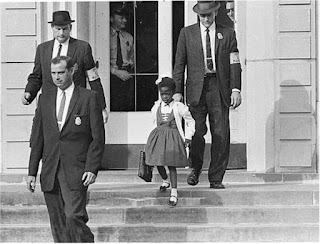I have been thinking about what I can do in the library to help my students gain empathy and start to have an understanding and knowledge about social justice issues. I feel that I need to start sharing stories and events with my students at an younger age. I recently read an article about gaining empathy and perspective. These are skills that need to be nurtured in young students and even our youngest students can walk in another’s shoes. I decided to share the story of Ruby Bridges with my Junior Kindergarten students this past month. This fit with many of the discussions that the teachers were having with students in the classroom and was an opportunity to talk to students about injustice and how to stand up to it.
We started by reading the book The Story of Ruby Bridges by Robert Coles. As we read the book we talked about what was happening in the story, including what segregation was and why it was unfair that people were treated differently by the color of their skin. We shared details about about Ruby Bridges’s real life and the fact that this is all a true story. We read the first half of the book and stopped on the page when Ruby was entering the school for the first time and white people were lined up yelling mean and ugly things at her, that US Marshals had to walk Ruby into the school to protect her and that many of the people in the crowd wanted to hurt her. We stopped the story there and students broke up into small groups with a teacher. We asked students to share what they thought Ruby was feeling at the moment. We asked students to put themselves in Ruby’s shoes and think about how they would feel if they were Ruby. Students shared that they would feel sad, lonely, scared, and angry. Some thought that she would want to run home, be with her mom and dad or go back to her old school where she was welcome. Others shared that maybe Ruby felt proud that she was helping bring about change and that she was brave.
The next week we finished the story and shared some of the historic details about Ruby’s life and what it was like after that first year of desegregation. Next we broke into small groups again with students and teachers and asked the students to think about what they would have done to stand up with Ruby Bridges. Students shared ideas like walking into school with her, holding her hand, telling the people that were being mean that they were wrong, telling people that everyone should be treated nicely, and being Ruby’s friend.
The final step of the project was to share a photo taken on Ruby’s first day of school that is part of the National Archives. We used the library’s green screen and the green screen app Do Ink to take a picture of each student standing in the historic picture with Ruby. Students then attached their picture to a poster sharing how they would stand up with Ruby Bridges. We shared these posters in a display in the library hallway and shared the students’ project at an all school assembly.
This project was really wonderful and showed me that even our youngest students have learn and have a conversation about topics of social justice. Students can gain empathy and understanding by reading books and talking about how the characters are feeling. I think as teachers in these difficult times it is more important than ever to help our student to gain empathy for others and be able to understand how someone else might be feeling and going through. I plan to do more projects like this in the future with not only my Junior Kindergarteners and my other students.



